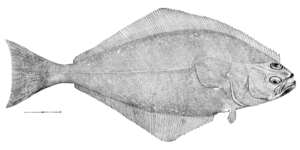
Within July 2014, a 219-kilogram (482 lb) Pacific halibut was caught in Glacier Bay, Alaska; this is, however, discounted from records because the halibut was shot and harpooned before being hauled aboard.
Dark brown on the top side with a white to off-white underbelly and have very small scales invisible to the naked eye embedded in their skin. Halibut are symmetrical at birth with one eye on each side of the head. Then, about six months later, during larval metamorphosis one eye migrates to the other side of the head. The eyes are permanently set once the skull is fully ossified. At the same time, the stationary-eyed side darkens to match the top side, while the other side remains white. This color scheme disguises halibut from above (blending with the ocean floor) and from below (blending into the light from the sky) and is known as countershading.
Thinking about doing some fishing, but where is the best fishing for halibut?
Alaska is the prime location for halibut fishing. Yakobi Island is an island in the Alexander Archipelago of southeastern Alaska, United States. Off Deer Harbor, almost any fish can be caught, including halibut.
As Food
Nutrition
Raw Pacific or Atlantic meat is 80% water and 19% protein, with negligible fat and no carbohydrates (table). In a 100-gram (3+1⁄2-ounce) reference amount, raw halibut contains rich content (20% of more of the Daily Value, DV) of protein, selenium (65% DV), phosphorus (34% DV), vitamin D (32% DV), and several B vitamins: niacin, vitamin B6, and vitamin B12 (42–46% DV).
Cooked meat – presumably through the resulting dehydration – has relatively increased protein content and reduced B vitamin content (per 100 grams), while magnesium, phosphorus, and selenium are rich in content.
Food preparation
Yield large fillets from both sides of the fish, with the small round cheeks providing an additional source of meat. Halibut are often boiled, deep-fried or grilled while fresh. Smoking is more difficult with halibut meat than it is with salmon, due to its ultra-low fat content. Eaten fresh, the meat has a clean taste and requires little seasoning. It is noted for its dense and firm texture.
Steamed halibut in black bean sauce
The Atlantic population was so depleted through overfishing that it might be declared an endangered species. According to Seafood Watch, consumers should avoid Atlantic halibut. Most halibut eaten on the East Coast of the United States is from the Pacific.
Food’s Sport History
In 2012, sport-fishermen in Cook Inlet reported increased instances of a condition known as “mushy halibut syndrome”. The meat of affected fish has a “jelly-like” consistency. When cooked it does not flake in the normal manner but rather falls apart. The meat is still perfectly safe to eat but the appearance and consistency are considered unappetizing. The exact cause of the condition is unknown but may be related to a change in diet.
Fishing Gear:
Lure Nectar
Lures
Assist Hooks
Swivels & Snaps
Sinkers & Weights
Leaders and Leader Rigging
Lures, Baits and Attractants
Lines
